-
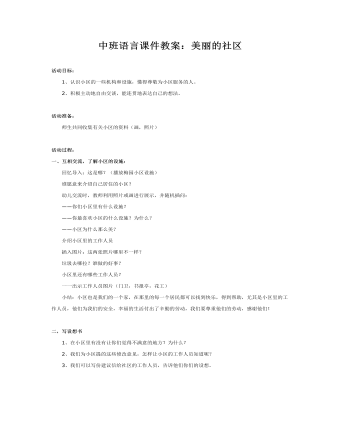
中班语言课件教案:美丽的社区
活动准备: 师生共同收集有关小区的资料(画,照片) 活动过程:一、互相交流,了解小区的设施: 回忆导入:这是哪?(播放梅园小区设施) 谁愿意来介绍自己居住的小区? 幼儿交流时,教师利用照片或画进行展示,并随机插问:——你们小区里有什么设施?
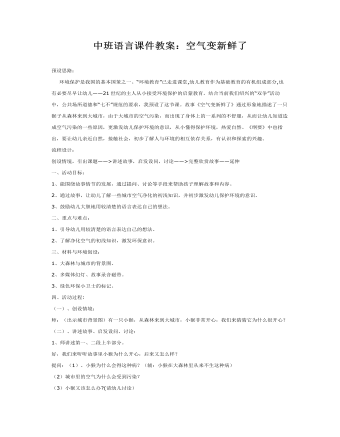
中班语言课件教案:空气变新鲜了
流程设计: 创设情境,引出课题——>讲述故事,启发设问,讨论——>完整欣赏故事——延伸 一、活动目标:1、能围绕故事情节的发展,通过提问、讨论等手段来帮助孩子理解故事和内容。 2、通过故事,让幼儿了解一些城市空气净化的初浅知识,并初步激发幼儿保护环境的意识。 3、鼓励幼儿大胆地用较清楚的语言表达自己的想法。 二、重点与难点:1、引导幼儿用较清楚的语言表达自己的想法。2、了解净化空气的初浅知识,激发环保意识。 三、材料与环境创设:1、大森林与城市的背景图。2、多媒体幻灯、故事录音磁带。 3、绿色环保小卫士的标记。 四、活动过程: (一)、创设情境:师:(出示城市背景图)有一只小猴,从森林来到大城市,小猴非常开心,我们来猜猜它为什么很开心?
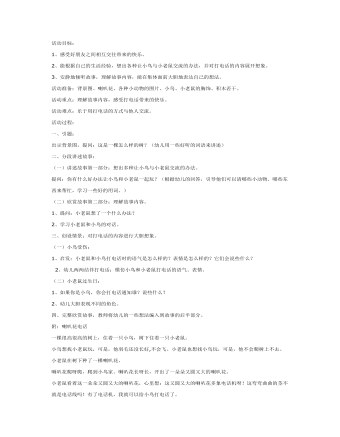
中班语言课件教案:喇叭花电话
2、能根据自己的生活经验,想出各种让小鸟与小老鼠交流的办法,并对打电话的内容展开想象。 3、安静地倾听故事,理解故事内容,能在集体面前大胆地表达自己的想法。 活动准备:背景图、喇叭花、各种小动物的图片、小鸟、小老鼠的胸饰、积木若干。 活动重点:理解故事内容,感受打电话带来的快乐。 活动难点:乐于用打电话的方式与他人交流。 活动过程: 一、引题: 出示背景图,提问:这是一棵怎么样的树?(幼儿用一些好听的词语来讲述) 二、分段讲述故事: (一)讲述故事第一部分:想出多种让小鸟与小老鼠交流的办法。 提问:你有什么好办法让小鸟和小老鼠一起玩?(根据幼儿的回答,引导他们可以请哪些小动物、哪些东西来帮忙,学习一些好的用词。) (二)欣赏故事第二部分:理解故事内容。 1、提问:小老鼠想了一个什么办法? 2、学习小老鼠和小鸟的对话。
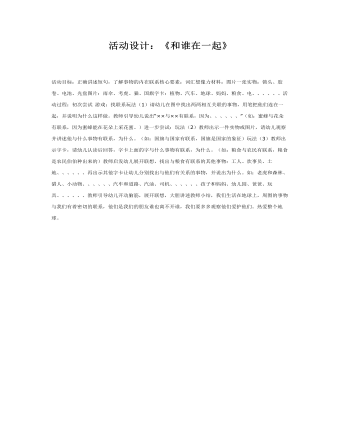
中班语言课件教案:和谁在一起
1)请幼儿在图中找出两两相互关联的事物,用笔把他们连在一起,并说明为什么这样做。教师引导幼儿说出“××与××有联系,因为、、、、、、”(如:蜜蜂与花朵有联系,因为蜜蜂能在花朵上采花蜜。)进一步尝试:玩法(2)教师出示一件实物或图片,请幼儿观察并讲述他与什么事物有联系,为什么。(如:国旗与国家有联系,国旗是国家的象征)玩法
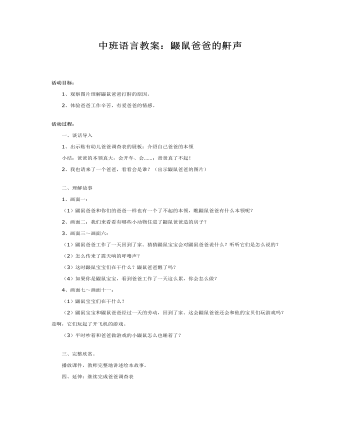
中班语言教案:鼹鼠爸爸的鼾声
活动过程: 一、谈话导入1、出示贴有幼儿爸爸调查表的展板:介绍自己爸爸的本领 小结:爸爸的本领真大,会开车、会……;爸爸真了不起!2、我也请来了一个爸爸,看看会是谁?(出示鼹鼠爸爸的图片) 二、理解故事1、画面一: (1)鼹鼠爸爸和你们的爸爸一样也有一个了不起的本领,瞧鼹鼠爸爸有什么本领呢?2、画面二:我们来看看有哪些小动物住进了鼹鼠爸爸造的房子?3、画面三~画面六: (1)鼹鼠爸爸工作了一天回到了家。猜猜鼹鼠宝宝会对鼹鼠爸爸说什么?听听它们是怎么说的? (2)怎么传来了震天响的呼噜声?
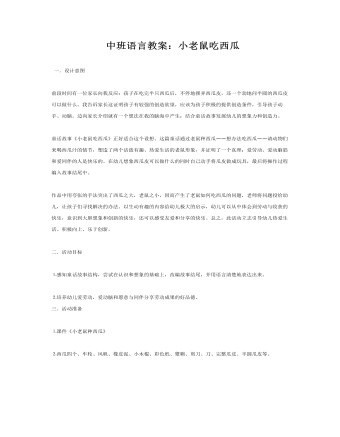
中班语言教案:小老鼠吃西瓜
二.活动目标⒈感知童话故事结构,尝试在认识和想象的基础上,改编故事结尾,并用语言清楚地表达出来。⒉培养幼儿爱劳动,爱动脑和愿意与同伴分享劳动成果的好品德。三.活动准备⒈课件《小老鼠种西瓜》⒉西瓜四个、车轮、风帆、橡皮泥、小木棍、彩色纸、漿糊、剪刀、刀、完整瓜皮、半圆瓜皮等。四.活动过程一、 欣赏故事⒈教师以提问的方法引出故事名称,引起幼儿注意。⒉讲述第一遍故事,边讲边播放 <BR><P></P>课件。(出现大西瓜和小老鼠在屏幕上,突出西瓜大、老鼠小)⒊讲述第二遍故事,边讲述边播放。(动画型式播放故事基本内容)
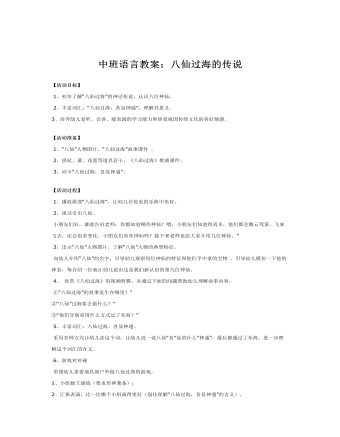
中班语言教案:八仙过海的传说
3、培养幼儿爱听、会讲、能表演的学习能力和热爱祖国传统文化的美好情感。【活动准备】 1、“八仙”人物图片,“八仙过海”故事课件。 2、拐杖、萧、花篮等道具若干,《八仙过海》歌曲课件。 3、词卡“八仙过海,各显神通”。【活动过程】 1、播放歌曲“八仙过海”,让幼儿在优美的乐曲中坐好。 2、谈话引出八仙。 小朋友们好,谁能告诉老师:你都知道哪些神仙?嗯,小朋友们知道得真多,他们都会腾云驾雾,飞来飞去,还会很多变化。小朋友们喜欢神仙吗?接下来老师也给大家介绍几位神仙。” 3、出示“八仙”人物图片,了解“八仙”人物的典型特征。 向幼儿介绍“八仙”的名字,引导幼儿观察每位神仙的特征和他们手中拿的宝物,引导幼儿模仿一下他的神态,每介绍一位就让幼儿说出这是我们新认识的第几位神仙。
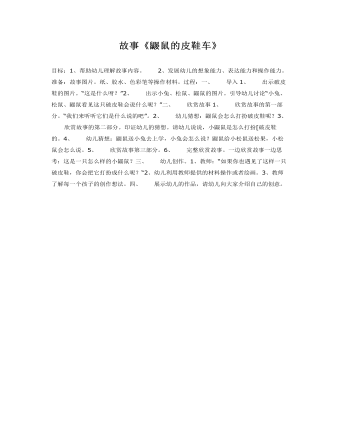
中班语言教案 鼹鼠的皮鞋车
2、发展幼儿的想象能力、表达能力和操作能力。准备:故事图片。纸、胶水、色彩笔等操作材料。过程:一、 导入1、 出示破皮鞋的图片。“这是什么呀?”2、 出示小兔、松鼠、鼹鼠的图片。引导幼儿讨论“小兔、松鼠、鼹鼠看见这只破皮鞋会说什么呢?”二、 欣赏故事1、 欣赏故事的第一部分。“我们来听听它们是什么说的吧”。2、 幼儿猜想:鼹鼠会怎么打扮破皮鞋呢?3、 欣赏故事的第二部分。印证幼儿的猜想。请幼儿说说,小鼹鼠是怎么打扮[破皮鞋的。
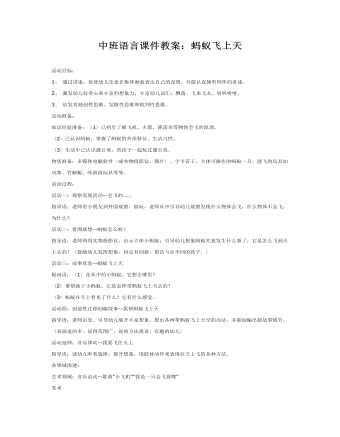
中班语言课件教案:蚂蚁飞上天
2、激发幼儿好奇心和丰富的想象力,丰富幼儿词汇:飘荡、飞来飞去、叽叽喳喳。3、启发其独创性思维、发散性思维和批判性思维。活动准备:知识经验准备:〈1〉已初步了解飞机、火箭、降落伞等物体会飞的原理。〈2〉已认识蚂蚁,掌握了蚂蚁的外形特征、生活习性。〈3〉生活中已认识蒲公英,带孩子一起玩过蒲公英。物质准备:多媒体电脑软件〈或实物投影仪、图片〉、字卡若干、立体可操作的蚂蚁一只、能飞的玩具如风筝、竹蜻蜓、吹泡泡玩具等等。活动过程:活动一:观察发现活动--会飞的……指导语:老师带小朋友到外面观察、游玩,老师从中引导幼儿观察发现什么物体会飞,什么物体不会飞;为什么?活动二:看图联想--蚂蚁怎么啦?指导语:老师利用实物投影仪,出示立体小蚂蚁;引导幼儿想象蚂蚁究竟发生什么事了,它是怎么飞到天上去的?〈鼓励幼儿发挥想象,肯定有创新、想法与众不同的孩子。〉

中班语言课件教案:北风和太阳
【活动目标】1、引导幼儿理解故事内容,知道北风爷爷和太阳公公其实各有所长。2、敢于在集体面前用较清楚的语言表达自己的观点。3、初步帮助幼儿树立自信心。 【活动准备】北风和太阳图片各一张。 【活动过程】 1、引起幼儿兴趣,帮助幼儿熟悉故事中的两个角色(1)出示北风和太阳师:它是谁?(北风)对,是北风爷爷。谁来说说看北风爷爷有什么本领?它又是谁?(太阳)太阳公公又有什么本领呢?(2)小结师:北风爷爷有北风爷爷的本领,太阳公公有太阳公公的本领,那它们两个究竟谁的本领更大呢?(引起幼儿听故事的兴趣)2、在讨论中帮助幼儿理解故事内容(1)讲故事第一部分师:有一天,北风爷爷和太阳公公发生了一次争吵,它们在争论谁的本领大,各人都夸自己的本领强。忽然看见一个人在赶路,他外面穿着一件大衣,于是他们决定谁能叫这个人把身上的大衣脱掉,谁就算赢了。
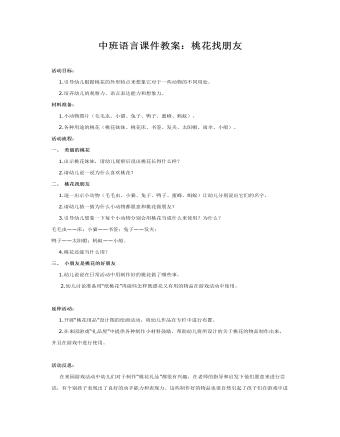
中班语言课件教案:桃花找朋友
材料准备: 1.小动物图片(毛毛虫、小猫、兔子、鸭子、蜜蜂、蚂蚁)。 2.各种用途的桃花(桃花妹妹、桃花床、书签、发夹、太阳帽、雨伞、小船)。活动流程:一、美丽的桃花 1.出示桃花妹妹,请幼儿观察后说出桃花长得什么样? 2.请幼儿说一说为什么喜欢桃花?二、桃花找朋友 1.逐一出示小动物(毛毛虫、小猫、兔子、鸭子、蜜蜂、蚂蚁)让幼儿分别说出它们的名字。 2.请幼儿猜一猜为什么小动物都愿意和桃花做朋友? 3.引导幼儿想象一下每个小动物分别会用桃花当成什么来使用?为什么?毛毛虫——床;小猫——书签;兔子——发夹;鸭子——太阳帽;蚂蚁——小船。 4.桃花还能当什么用?
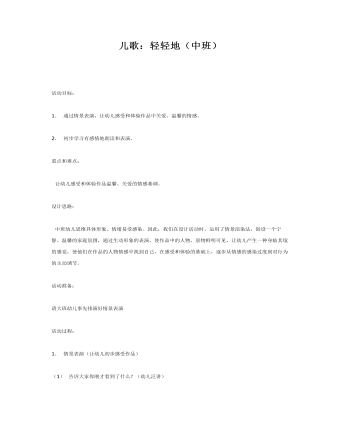
中班语言课件教案:儿歌轻轻地
2. 初步学习有感情地朗读和表演。重点和难点: 让幼儿感受和体验作品温馨、关爱的情感基调。设计思路: 中班幼儿思维具体形象、情绪易受感染。因此,我们在设计活动时,运用了情景渲染法,创设一个宁静、温馨的家庭氛围,通过生动形象的表演,使作品中的人物、景物鲜明可见,让幼儿产生一种身临其境的感觉,使他们在作品的人物情感中找到自己,在感受和体验的基础上,逐步从情感的感染过度到对行为的主动调节。活动准备:请大班幼儿事先排演好情景表演
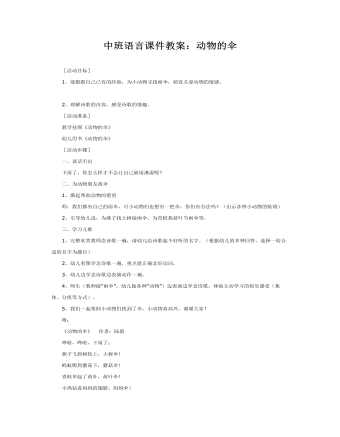
中班语言课件教案:动物的伞
2、理解诗歌的内容,感受诗歌的情趣。 [活动准备] 教学挂图《动物的伞》 幼儿用书《动物的伞》 [活动步骤] 一、谈话引出 下雨了,你怎么样才不会让自己被雨淋湿呢?
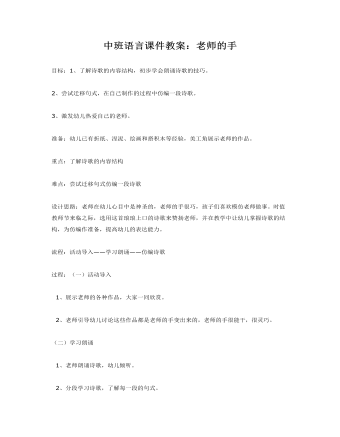
中班语言课件教案:老师的手
2、尝试迁移句式,在自己制作的过程中仿编一段诗歌。3、激发幼儿热爱自己的老师。准备:幼儿已有折纸、涅泥、绘画和搭积木等经验,美工角展示老师的作品。重点:了解诗歌的内容结构难点:尝试迁移句式仿编一段诗歌设计思路:老师在幼儿心目中是神圣的,老师的手很巧,孩子们喜欢模仿老师做事。时值教师节来临之际,选用这首琅琅上口的诗歌来赞扬老师,并在教学中让幼儿掌握诗歌的结构,为仿编作准备,提高幼儿的表达能力。流程:活动导入——学习朗诵——仿编诗歌过程:(一)活动导入 1、展示老师的各种作品,大家一同欣赏。 2、老师引导幼儿讨论这些作品都是老师的手变出来的,老师的手很能干,很灵巧。(
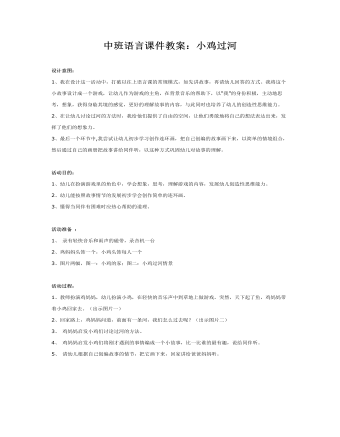
中班语言课件教案:小鸡过河
2、在让幼儿讨论过河的方法时,我给他们提供了自由的空间,让他们勇敢地将自己的想法表达出来,发挥了他们的想象力。 3、最后一个环节中,我尝试让幼儿初步学习创作连环画,把自己创编的故事画下来,以简单的情境组合,然后通过自己的画册把故事讲给同伴听,以这种方式巩固幼儿对故事的理解。活动目的:1、幼儿在扮演游戏里的角色中,学会想象,思考,理解游戏的内容,发展幼儿创造性思维能力。 2、幼儿能按照故事情节的发展初步学会创作简单的连环画。 3、懂得当同伴有困难时应热心帮助的道理。
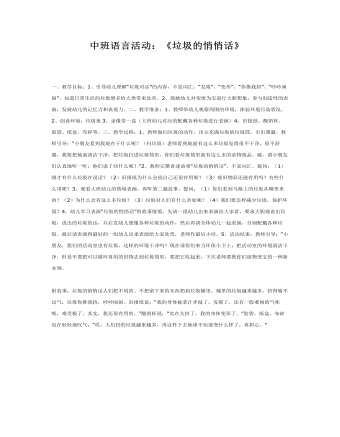
中班语言课件教案:垃圾的悄悄话
3、录像带一盒(大班幼儿对应的配戴各种垃圾进行表演)4、旧报纸、酸奶杯、胶袋、纸盒、布碎等。三、教学过程:1、教师做扫垃圾的动作,出示充满垃圾的垃圾筒,引出课题。教师引导:“小朋友看到我现在干什么呢?(扫垃圾)老师看到地面有这么多垃圾觉得很不干净,很不舒服,我要把地面清洁干净,把垃圾扫进垃圾筒里,你们看垃圾筒里面有这么多的杂物废品。嘘,请小朋友们认真地听一听,他们说了些什么呢?”2、教师完整讲述故事“垃圾的悄悄话”,丰富词汇。提问:(1)刚才有什么垃圾在说话?(2)旧报纸为什么会说自己还很有用呢?(3)废旧物品还能有用吗?有些什么用呢?3、观看大班幼儿的情境表演,再听第二遍故事。提问:(1)你们看到马路上的垃圾从哪里来的?(2)为什么会有这么多垃圾?
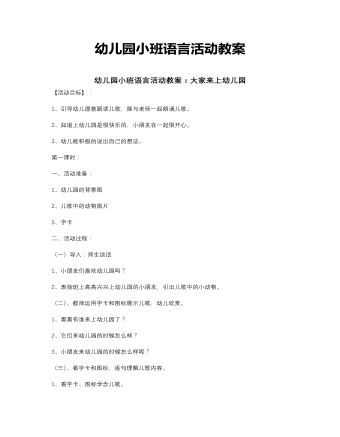
幼儿园语言课活动教案
第一课时: 一、活动准备: 1、幼儿园的背景图 2、儿歌中的动物图片 3、字卡 二、活动过程: (一)导入:师生谈话 1、小朋友们喜欢幼儿园吗? 2、表扬班上高高兴兴上幼儿园的小朋友,引出儿歌中的小动物。

中班艺术:我来设计课件教案
活动目标:1、在对自己的家进行观察后,能大胆地表达出自己的见解。2、充分发挥幼儿的想象,设计自己心中的家庭用具。活动准备:1、课前对自己家进行观察。2、积木若干;绘画材料。3、多媒体课件。活动过程:一、课件出示,直导课题。 前几天,我们说起了家,都说自己家里的东西好,那请你们来讲讲看,你们家的什么东西好,好在什么地方?(鼓励幼儿发表见解)二、启发讨论。 今天老师给你们带来了一个“家”,你们来看看,这个家怎么样?(引导幼儿讨论`如何为这个家设计家庭用具)
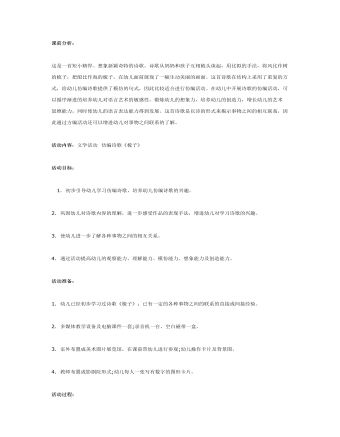
中班语言课件教案:故事:鼠宝宝学外语
活动内容:文学活动 仿编诗歌《梳子》活动目标: 1. 初步引导幼儿学习仿编诗歌,培养幼儿仿编诗歌的兴趣。2. 巩固幼儿对诗歌内容的理解,进一步感受作品的表现手法,增进幼儿对学习诗歌的兴趣。3. 使幼儿进一步了解各种事物之间的相互关系。4. 通过活动提高幼儿的观察能力、理解能力、模仿能力、想象能力及创造能力。活动准备:1. 幼儿已经初步学习过诗歌《梳子》;已有一定的各种事物之间的联系的直接或间接经验。2. 多媒体教学设备及电脑课件一套;录音机一台、空白磁带一盒。3. 室外布置成美术图片展览馆,在课前带幼儿进行参观;幼儿操作卡片及背景图。 4. 教师布置成影剧院形式;幼儿每人一张写有数字的图形卡片。

中班语言课件教案:大象救小兔子
教学目标: 1、观察图片,讲述故事中角色对话。 2、懂得同伴之间应该相互关心、相互帮助的道理。 3、初步培养幼儿讲故事和表演故事的能力。 准备: 背景图一幅,小兔、大象、老虎(插入教具),头饰若干。。 过程: 一、进入主题。(音乐响起),带小朋友到树林里去玩玩。出示背景图。 二、演示教具,启发提问,引导幼儿讲述。 1、问:谁在小树林里?干什么?讨论后总结:小白兔、小灰兔、小黑兔在树林里高高兴兴地玩着。(学习词“高高兴兴”)。 2、插入老虎。哎呀!谁来了?它来干什么?小兔子们怎么办?总结:突然,从树林里窜出一只大老虎,它张着大大的嘴,露着尖尖的牙,要来抓小兔子,小兔子吓得转身就逃。(学习词“窜”)。





















